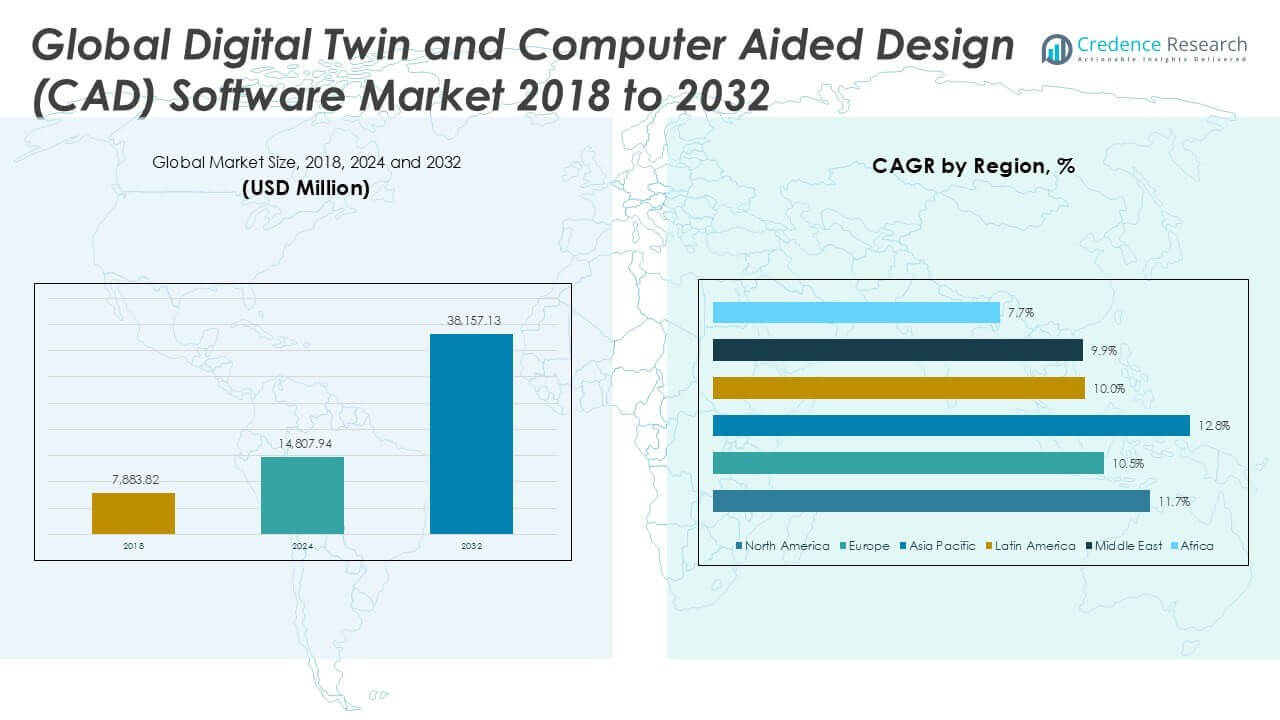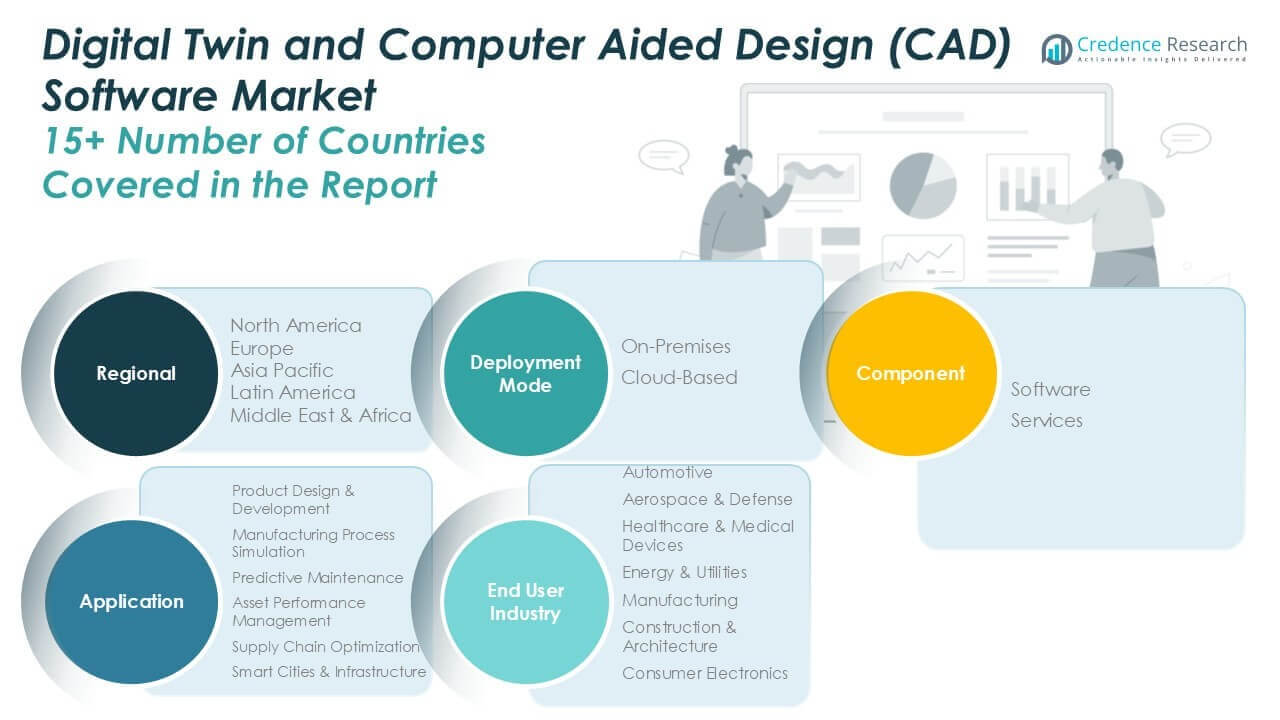CHAPTER NO. 1: GENESIS OF THE MARKET
1.1 Market Prelude – Introduction & Scope
1.2 The Big Picture – Objectives & Vision
1.3 Strategic Edge – Unique Value Proposition
1.4 Stakeholder Compass – Key Beneficiaries
CHAPTER NO. 2: EXECUTIVE LENS
2.1 Pulse of the Industry – Market Snapshot
2.2 Growth Arc – Revenue Projections (USD Million)
2.3. Premium Insights – Based on Primary Interviews
CHAPTER NO. 3: DIGITAL TWIN AND COMPUTER AIDED DESIGN (CAD) SOFTWARE MARKET FORCES & INDUSTRY PULSE
3.1 Foundations of Change – Market Overview
3.2 Catalysts of Expansion – Key Market Drivers
3.2.1 Momentum Boosters – Growth Triggers
3.2.2 Innovation Fuel – Disruptive Technologies
3.3 Headwinds & Crosswinds – Market Restraints
3.3.1 Regulatory Tides – Compliance Challenges
3.3.2 Economic Frictions – Inflationary Pressures
3.4 Untapped Horizons – Growth Potential & Opportunities
3.5 Strategic Navigation – Industry Frameworks
3.5.1 Market Equilibrium – Porter’s Five Forces
3.5.2 Ecosystem Dynamics – Value Chain Analysis
3.5.3 Macro Forces – PESTEL Breakdown
3.6 Price Trend Analysis
3.6.1 Regional Price Trend
3.6.2 Price Trend by product
CHAPTER NO. 4: KEY INVESTMENT EPICENTER
4.1 Regional Goldmines – High-Growth Geographies
4.2 Product Frontiers – Lucrative Product Categories
4.3 Component Sweet Spots – Emerging Demand Segments
CHAPTER NO. 5: REVENUE TRAJECTORY & WEALTH MAPPING
5.1 Momentum Metrics – Forecast & Growth Curves
5.2 Regional Revenue Footprint – Market Share Insights
5.3 Segmental Wealth Flow – Deployment Model & Component Revenue
CHAPTER NO. 6: TRADE & COMMERCE ANALYSIS
6.1.Import Analysis by Region
6.1.1. Global Digital Twin and Computer Aided Design (CAD) Software Market Import Revenue By Region
6.2.Export Analysis by Region
6.2.1. Global Digital Twin and Computer Aided Design (CAD) Software Market Export Revenue By Region
CHAPTER NO. 7: COMPETITION ANALYSIS
7.1.Company Market Share Analysis
7.1.1. Global Digital Twin and Computer Aided Design (CAD) Software Market: Company Market Share
7.2. Global Digital Twin and Computer Aided Design (CAD) Software Market Company Revenue Market Share
7.3.Strategic Developments
7.3.1.Acquisitions & Mergers
7.3.2. New Product Launch
7.3.3. Regional Expansion
7.4. Competitive Dashboard
7.5. Company Assessment Metrics, 2024
CHAPTER NO. 8: DIGITAL TWIN AND COMPUTER AIDED DESIGN (CAD) SOFTWARE MARKET – BY DEPLOYMENT MODEL SEGMENT ANALYSIS
8.1. Digital Twin and Computer Aided Design (CAD) Software Market Overview by Deployment Model Segment
8.1.1. Digital Twin and Computer Aided Design (CAD) Software Market Revenue Share By Deployment Model
8.2. On-Premises
8.3. Cloud-Based
CHAPTER NO. 9: DIGITAL TWIN AND COMPUTER AIDED DESIGN (CAD) SOFTWARE MARKET – BY COMPONENT SEGMENT ANALYSIS
9.1. Digital Twin and Computer Aided Design (CAD) Software Market Overview by Component Segment
9.1.1. Digital Twin and Computer Aided Design (CAD) Software Market Revenue Share By Component
9.2. Software
9.3. Services
CHAPTER NO. 10: DIGITAL TWIN AND COMPUTER AIDED DESIGN (CAD) SOFTWARE MARKET – BY APPLICATION SEGMENT ANALYSIS
10.1. Digital Twin and Computer Aided Design (CAD) Software Market Overview by Application Segment
10.1.1. Digital Twin and Computer Aided Design (CAD) Software Market Revenue Share By Application
10.2. Product Design & Development
10.3. Manufacturing Process Simulation
10.4. Predictive Maintenance
10.5. Asset Performance Management
10.6. Supply Chain Optimization
10.7. Smart Cities & Infrastructure
CHAPTER NO. 11: DIGITAL TWIN AND COMPUTER AIDED DESIGN (CAD) SOFTWARE MARKET – BY END USER INDUSTRY SEGMENT ANALYSIS
11.1. Digital Twin and Computer Aided Design (CAD) Software Market Overview by End User Industry Segment
11.1.1. Digital Twin and Computer Aided Design (CAD) Software Market Revenue Share By End User Industry
11.2. Automotive
11.3. Aerospace and Defense
11.4. Healthcare & Medical Devices
11.5. Energy & Utilities
11.6. Manufacturing
11.7. Construction & Architecture
11.8. Consumer Electronics
CHAPTER NO. 12: DIGITAL TWIN AND COMPUTER AIDED DESIGN (CAD) SOFTWARE MARKET – REGIONAL ANALYSIS
12.1. Digital Twin and Computer Aided Design (CAD) Software Market Overview by Region Segment
12.1.1. Global Digital Twin and Computer Aided Design (CAD) Software Market Revenue Share By Region
12.1.2.Regions
12.1.3.Global Digital Twin and Computer Aided Design (CAD) Software Market Revenue By Region
12.1.4.Deployment Model
12.1.5.Global Digital Twin and Computer Aided Design (CAD) Software Market Revenue By Deployment Model
12.1.6.Component
12.1.7. Global Digital Twin and Computer Aided Design (CAD) Software Market Revenue By Component
12.1.8. Application
12.1.9. Global Digital Twin and Computer Aided Design (CAD) Software Market Revenue By Application
12.1.10. End User Industry
12.1.11. Global Digital Twin and Computer Aided Design (CAD) Software Market Revenue By End User Industry
CHAPTER NO. 13: NORTH AMERICA DIGITAL TWIN AND COMPUTER AIDED DESIGN (CAD) SOFTWARE MARKET – COUNTRY ANALYSIS
13.1.North America Digital Twin and Computer Aided Design (CAD) Software Market Overview by Country Segment
13.1.1.North America Digital Twin and Computer Aided Design (CAD) Software Market Revenue Share By Region
13.2.North America
13.2.1. North America Digital Twin and Computer Aided Design (CAD) Software Market Revenue By Country
13.2.2.Deployment Model
13.2.3. North America Digital Twin and Computer Aided Design (CAD) Software Market Revenue By Deployment Model
13.2.4.Component
13.2.5. North America Digital Twin and Computer Aided Design (CAD) Software Market Revenue By Component
13.2.6. Application
13.2.7. North America Digital Twin and Computer Aided Design (CAD) Software Market Revenue By Application
13.2.8.End User Industry
13.2.9. North America Digital Twin and Computer Aided Design (CAD) Software Market Revenue By End User Industry
13.3.U.S.
13.4.Canada
13.5.Mexico
CHAPTER NO. 14: EUROPE DIGITAL TWIN AND COMPUTER AIDED DESIGN (CAD) SOFTWARE MARKET – COUNTRY ANALYSIS
14.1. Europe Digital Twin and Computer Aided Design (CAD) Software Market Overview by Country Segment
14.1.1. Europe Digital Twin and Computer Aided Design (CAD) Software Market Revenue Share By Region
14.2.Europe
14.2.1. Europe Digital Twin and Computer Aided Design (CAD) Software Market Revenue By Country
14.2.2.Deployment Model
14.2.3.Europe Digital Twin and Computer Aided Design (CAD) Software Market Revenue By Deployment Model
14.2.4.Component
14.2.5. Europe Digital Twin and Computer Aided Design (CAD) Software Market Revenue By Component
14.2.6. Application
14.2.7. Europe Digital Twin and Computer Aided Design (CAD) Software Market Revenue By Application
14.2.8.End User Industry
14.2.9. Europe Digital Twin and Computer Aided Design (CAD) Software Market Revenue By End User Industry
14.3.UK
14.4.France
14.5.Germany
14.6.Italy
14.7.Spain
14.8.Russia
14.9. Rest of Europe
CHAPTER NO. 15: ASIA PACIFIC DIGITAL TWIN AND COMPUTER AIDED DESIGN (CAD) SOFTWARE MARKET – COUNTRY ANALYSIS
15.1. Asia Pacific Digital Twin and Computer Aided Design (CAD) Software Market Overview by Country Segment
15.1.1. Asia Pacific Digital Twin and Computer Aided Design (CAD) Software Market Revenue Share By Region
15.2.Asia Pacific
15.2.1. Asia Pacific Digital Twin and Computer Aided Design (CAD) Software Market Revenue By Country
15.2.2.Deployment Model
15.2.3. Asia Pacific Digital Twin and Computer Aided Design (CAD) Software Market Revenue By Deployment Model
15.2.4.Component
15.2.5. Asia Pacific Digital Twin and Computer Aided Design (CAD) Software Market Revenue By Component
15.2.6. Application
15.2.7. Asia Pacific Digital Twin and Computer Aided Design (CAD) Software Market Revenue By Application
15.2.8.End User Industry
15.2.9. Asia Pacific Digital Twin and Computer Aided Design (CAD) Software Market Revenue By End User Industry
15.3.China
15.4.Japan
15.5.South Korea
15.6.India
15.7.Australia
15.8.Southeast Asia
15.9. Rest of Asia Pacific
CHAPTER NO. 16: LATIN AMERICA DIGITAL TWIN AND COMPUTER AIDED DESIGN (CAD) SOFTWARE MARKET – COUNTRY ANALYSIS
16.1. Latin America Digital Twin and Computer Aided Design (CAD) Software Market Overview by Country Segment
16.1.1.Latin America Digital Twin and Computer Aided Design (CAD) Software Market Revenue Share By Region
16.2. Latin America
16.2.1. Latin America Digital Twin and Computer Aided Design (CAD) Software Market Revenue By Country
16.2.2.Deployment Model
16.2.3. Latin America Digital Twin and Computer Aided Design (CAD) Software Market Revenue By Deployment Model
16.2.4.Component
16.2.5. Latin America Digital Twin and Computer Aided Design (CAD) Software Market Revenue By Component
16.2.6. Application
16.2.7. Latin America Digital Twin and Computer Aided Design (CAD) Software Market Revenue By Application
16.2.8.End User Industry
16.2.9.Latin America Digital Twin and Computer Aided Design (CAD) Software Market Revenue By End User Industry
16.3.Brazil
16.4.Argentina
16.5.Rest of Latin America
CHAPTER NO. 17: MIDDLE EAST DIGITAL TWIN AND COMPUTER AIDED DESIGN (CAD) SOFTWARE MARKET – COUNTRY ANALYSIS
17.1. Middle East Digital Twin and Computer Aided Design (CAD) Software Market Overview by Country Segment
17.1.1.Middle East Digital Twin and Computer Aided Design (CAD) Software Market Revenue Share By Region
17.2.Middle East
17.2.1. Middle East Digital Twin and Computer Aided Design (CAD) Software Market Revenue By Country
17.2.2.Deployment Model
17.2.3. Middle East Digital Twin and Computer Aided Design (CAD) Software Market Revenue By Deployment Model
17.2.4.Component
17.2.5. Middle East Digital Twin and Computer Aided Design (CAD) Software Market Revenue By Component
17.2.6. Application
17.2.7. Middle East Digital Twin and Computer Aided Design (CAD) Software Market Revenue By Application
17.2.8. End User Industry
17.2.9. Middle East Digital Twin and Computer Aided Design (CAD) Software Market Revenue By End User Industry
17.3.GCC Countries
17.4. Israel
17.5. Turkey
17.6.Rest of Middle East
CHAPTER NO. 18: AFRICA DIGITAL TWIN AND COMPUTER AIDED DESIGN (CAD) SOFTWARE MARKET – COUNTRY ANALYSIS
18.1. Africa Digital Twin and Computer Aided Design (CAD) Software Market Overview by Country Segment
18.1.1. Africa Digital Twin and Computer Aided Design (CAD) Software Market Revenue Share By Region
18.2. Africa
18.2.1.Africa Digital Twin and Computer Aided Design (CAD) Software Market Revenue By Country
18.2.2.Deployment Model
18.2.3.Africa Digital Twin and Computer Aided Design (CAD) Software Market Revenue By Deployment Model
18.2.4.Component
18.2.5. Africa Digital Twin and Computer Aided Design (CAD) Software Market Revenue By Component
18.2.6.Application
18.2.7. Africa Digital Twin and Computer Aided Design (CAD) Software Market Revenue By Application
18.2.8.End User Industry
18.2.9. Africa Digital Twin and Computer Aided Design (CAD) Software Market Revenue By End User Industry
18.3. South Africa
18.4.Egypt
18.5.Rest of Africa
CHAPTER NO. 19: COMPANY PROFILES
19.1. Dassault Systèmes
19.1.1.Company Overview
19.1.2.Product Portfolio
19.1.3.Financial Overview
19.1.4.Recent Developments
19.1.5.Growth Strategy
19.1.6.SWOT Analysis
19.2. Autodesk, Inc.
19.3. PTC Inc.
19.4. Siemens AG
19.5. AVEVA Group plc
19.6. Hexagon AB
19.7. Bentley Systems, Inc.
19.8. ANSYS, Inc.
19.9. Altair Engineering, Inc.
19.10. Bricsys (BricsCAD)
19.11. Zuken Inc.
19.12. Lectra
19.13. Nemetschek SE
19.14. AVEVA Group plc

 Market Insights
Market Insights






